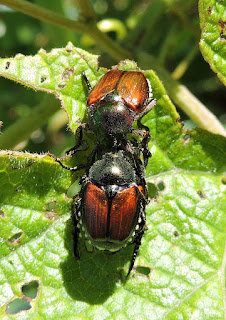 |
| Blue-winged Scoliid Wasp - Patty Hatcher |
I was preparing a blog on the double-banded scoliid wasp, Scolia bincincta which Ben Caruther's had photographed earlier in the month so this is our Scoliid Special.
The Scoliidae family of wasps has 20 species in the US. According to UF Featured Creatures,
"The family Scoliidae is composed of fairly large, stout-bodied wasps, often brightly patterned in shades of red and yellow, white, or one of these colors in combination with black. These wasps are parasitoids of soil-inhabiting scarab beetle larvae. "
 Scarab beetles are in a large family with 1400 species to choose from in the US, some of which are shown on this Bugguide link. There are many common species including the May and June beetles, Hercules beetles, dung beetles and the never popular pesky Japanese beetles.
Scarab beetles are in a large family with 1400 species to choose from in the US, some of which are shown on this Bugguide link. There are many common species including the May and June beetles, Hercules beetles, dung beetles and the never popular pesky Japanese beetles.
All have in common grubs that live underground until emerging, sometimes damaging lawns. In their defense I would point out that they were here 270 million years before the invention of the lawnmower.
The female Scoliid wasp uses her special powers to locate the grub underground,
find and sting it into a zombie-like state and lay her egg on it,
leaving it buried. The larva emerges from the egg, feeds on the
immobile but living grub for two weeks and then forms its cocoon where
it spends the winter.* When the adult wasps emerge they consume nectar and pollen, incidentally moving pollen from plant to plant.
*The whole Scoliid life cycle is described in detail by Bug Eric.


